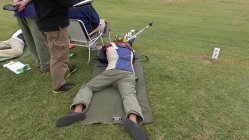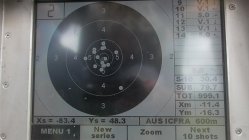I'm running some calcs using Daniel Lilja's article: http://riflebarrels.com/the-ideal-barrel-for-a-308-tactical-rifle/
Knowing that the rifle after installing the clamp has a 20 inch length of the barrel free floating instead of 30 inches, I can calculate the relative muzzle deflection using his formula:
"The basic formula for calculation of muzzle deflection is:
D = (W*l^3)/3*E*Ix
Where: D is the deflection at the muzzle in inches, W is the force or load applied at the muzzle in pounds, l is the free length of the barrel in inches (not including threads), E is the modulus of elasticity or Young’s modulus for the barrel material, and Ix is the moment of inertia for the barrel."
That means that "For a round beam, like a barrel, its rigidity increases with the 4th power of its diameter but decreases with the 3rd power of its length."
So the muzzle deflection on a 30 inch barrel secure clamped leaving 20 inches out is according to the article, and extrapolating the last 2 inches: 0.000787" instead of 0.003223. So it is 4.1 times stiffer.
Also, it retains the velocity of a 30" barrel (mine is at 2976 fps av) with the accuracy of a 20 inch barrel. If it would be 20" the equivalent velocity would be 2780 fps, according to : http://rifleshooter.com/2014/12/308-winchester-7-62x51mm-nato-barrel-length-versus-velocity-28-to-16-5/
http://truthaboutguns-zippykid.netdna-ssl.com/wp-content/uploads/2013/09/13.png
Looking at this graph, keep in mind that less is more= less radial moa, smaller group. Also, look at the shorter ranges where all of the projectiles are travelling at very similar retained velocities. No point looking at the 900 y range. I'd think 300 yards reflects the differences the best in terms of accuracy related to the amplitude of the muzzle deflection (projectile has gone to sleep, precession is minimized because the aerodinamics have taken over the effects of the internal ballistics and the pich up and gyroscopic/ spin drift effects haven't really kicked in).
Lets look at barrel vibration:
The 3rd harmonic (donut shaped expansion shock that travels forwards and backwards the barrel from chamber to muzzle and back) is related to the speed of sound of the metal that the barrel is made of and the chamber to muzzle length of said barrel. That will not change because the barrel is still 30 inches long.
2nd and 1st harmonics are related to the ratio of length vs width of the free floating section of the barrel i.e.- it's rigidity.
So for equivalent energy, Frequency=1/wavelength. Meaning, the barrel will vibrate at 4 times the previous frequency with a quarter of the amplitude. So each stroke of vibration (and that goes to muzzle deflection as well) is only 1/4 of the amplitude of previous set up of this rig.
My guess?
The maths might be right because the barrel was ringing at a MUCH higher pitch when it was being shot. AND the rifle went out of tune (ammo loads).
If the maths stack up in the real world it means that we will have larger nodes, and the rifle becomes more tolerant to powder and proj changes.
Keep in mind that the stock forend is way more rigid than the barrel itself so torsion and pitch momentums are on a different scale and could be negligible for the scale that we are working in.
Now I'm really curious about this...
A BIG Thank You to Lilja Barrels, rifleshooter.com and to Truth About Guns for making this precious information available publicly. You guys Rock














![13[1].png](/data/attachments/30/30269-216de535be90c00f196a50b6a9cf6105.jpg?hash=IW3lNb6QwA)
